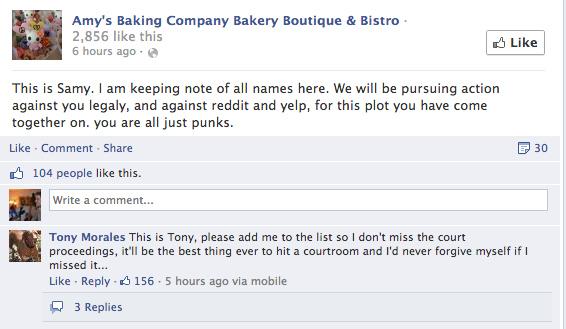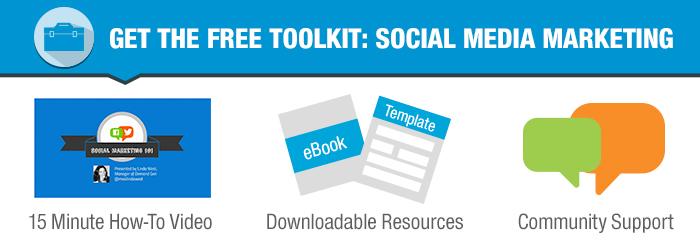We’ve all made social media faux pas before – a few weeks ago, I accidentally sent a group of friends what I thought was a recipe. It turned out to be an accidental selfie I had taken while unaware that my camera was open, in which I bore a striking resemblance to a female (and extremely vacant) Gollum. I’m fairly certain my friends will never stop mocking me for this picture, but in the world of social media marketing, mistakes can have much worse consequences.
Take, for one remarkable example, the Amy’s Baking Company debacle. This small restaurant had gotten bad reviews from bloggers and diners, and turned to a celebrity chef for help. Amy’s Baking was featured on Gordon Ramsay’s Kitchen Nightmares, a television program in which noted chef Ramsay helps faltering restaurants improve. Ramsay and the restaurant’s owners clashed (yes, that’s an understatement) and the whole thing blew up on social media. Forbes called it a poster example of how a business should not react to comments posted on social media.
There are many less-flashy (but just as deadly) ways to screw up your social media marketing efforts; here are 5 more of them:
1. Saying: Look at me, look at me, look at me!
The first and most obvious social media sin is spamming. Just published a blog post? That’s great, but your Facebook, LinkedIn, Twitter, and Google+ followers don’t want to hear about it ten times in an hour, especially if any of them follow you on more than one platform. This doesn’t mean you should post about content only once – doing so three or four times over a day can be extremely effective at reaching people who live in different time zones or who might not have seen your tweet or status update earlier – but don’t bombard your followers with innumerable reminders and requests to look at your content, or they may be tempted to avoid it entirely out of annoyance.
2. Asking for follows.
Following random people on various social media platforms, and then asking them to follow you in return, is tacky and makes you seem desperate. Though some celebrities and corporations buy followers to make them look more popular than they actually are, theirs is not the example you want to follow, and you shouldn’t be following anyone solely for the purpose of having them follow you back. If you produce good content and follow people and organizations whom you’re genuinely interested in, you will build up and retain your audience naturally; if not, the people who you bother into following you will likely unfollow you in a few weeks or even days.
3. Using social media as a megaphone.
Failing to join the conversation is a rookie mistake. If you post a Facebook status and someone comments with a question, there is no reason that you shouldn’t respond to it. And yet, it’s truly surprising how many corporations will post content and then completely miss the chance to interact with their audiences. Be present in the comments section of your blog; if you have a Twitter account, reply to at least some of the people who tweet at you. One of the main benefits of social media is the ability to engage and connect with people you otherwise wouldn’t be able to reach, and if you’re using your platforms as nothing but mouthpieces to promote your content, you’re missing out on a big opportunity.
4. Failing to review before posting.
Not taking the time to review your posts thoroughly before they go public can not only be embarrassing but can in some cases get you fired. It’s shocking how many simple social media mistakes can slip through the cracks. Check the text of each post for spelling and grammatical errors; if you’re attaching a link, check to make sure that it’s not broken and that it sends those who click it where you want them to go.
If your post includes an image, make sure you’re attaching the image you actually want to share. It’s easy to delete tweets and posts, but if someone takes a screenshot of your mistake, it may live in Internet infamy for the rest of eternity, just as I’m sure my Gollum selfie will be held against me by my friends for the rest of my life.
Additionally, check your links and pictures across different browsers and mobile devices to ensure that they work across the board. Unnecessary errors can reduce the number of people that see your content and erode your credibility as a brand – and that’s the last thing you want.
5. Piggybacking on a trending tragedy.
Possibly the most grievous social media mistake you can make, one which people will not soon forget (or forgive), is capitalizing on tragic current events to gain exposure. Apparently, this is not common sense to all companies. After the 2012 Aurora movie theater shooting, CelebBoutique tweeted the following: “#Aurora is trending, clearly about our Kim K inspired #Aurora dress ;)”. Their excuse was that they had seen the trending hashtag “#Aurora” and had not bothered to check what it was about, which didn’t stop the tweet from being horribly offensive.
After the Boston Marathon bombing, Epicurious tried to promote its cranberry scones “in honor of Boston and New England,” and on September 11th, 2013, AT&T was heavily criticized for posting this picture, which looked more like a promotional ploy than a sincere memorial, on its Twitter, Facebook, and Instagram pages. What we’ve learned from these incidents is that it’s important to make sure a trending topic you’re planning to reference in a post does not concern a tragedy; and, that unless a current event is a positive one, it’s in extremely poor taste to try and leverage it.
Social media etiquette is important on a small personal scale, but matters even more when you’re representing your company. So take the time to make sure your social media is the best that it can be, and check out our free social media marketing toolkit to get started.
Photo: “when you accidentally open your front camera” by meanplastic


